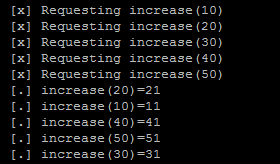- ubuntu12.04环境下使用kvm ioctl接口实现最简单的虚拟机
- Ubuntu 通过无线网络安装Ubuntu Server启动系统后连接无线网络的方法
- 在Ubuntu上搭建网桥的方法
- ubuntu 虚拟机上网方式及相关配置详解
CFSDN坚持开源创造价值,我们致力于搭建一个资源共享平台,让每一个IT人在这里找到属于你的精彩世界.
这篇CFSDN的博客文章详解Python操作RabbitMQ服务器消息队列的远程结果返回由作者收集整理,如果你对这篇文章有兴趣,记得点赞哟.
先说一下笔者这里的测试环境:Ubuntu14.04 + Python 2.7.4 RabbitMQ服务器 。
|
1
|
sudo
apt-get
install
rabbitmq-server
|
Python使用RabbitMQ需要Pika库 。
|
1
|
sudo
pip
install
pika
|
远程结果返回 消息发送端发送消息出去后没有结果返回。如果只是单纯发送消息,当然没有问题了,但是在实际中,常常会需要接收端将收到的消息进行处理之后,返回给发送端.
处理方法描述:发送端在发送信息前,产生一个接收消息的临时队列,该队列用来接收返回的结果。其实在这里接收端、发送端的概念已经比较模糊了,因为发送端也同样要接收消息,接收端同样也要发送消息,所以这里笔者使用另外的示例来演示这一过程.
示例内容:假设有一个控制中心和一个计算节点,控制中心会将一个自然数N发送给计算节点,计算节点将N值加1后,返回给控制中心。这里用center.py模拟控制中心,compute.py模拟计算节点.
compute.py代码分析 。
|
1
2
3
4
5
6
7
8
9
10
11
12
13
14
15
16
17
18
19
20
21
22
23
24
25
26
27
28
29
30
31
32
33
|
#!/usr/bin/env python
#coding=utf8
import
pika
#连接rabbitmq服务器
connection
=
pika.BlockingConnection(pika.ConnectionParameters(
host
=
'localhost'
))
channel
=
connection.channel()
#定义队列
channel.queue_declare(queue
=
'compute_queue'
)
print
' [*] Waiting for n'
#将n值加1
def
increase(n):
return
n
+
1
#定义接收到消息的处理方法
def
request(ch, method, properties, body):
print
" [.] increase(%s)"
%
(body,)
response
=
increase(
int
(body))
#将计算结果发送回控制中心
ch.basic_publish(exchange
=
'',
routing_key
=
properties.reply_to,
body
=
str
(response))
ch.basic_ack(delivery_tag
=
method.delivery_tag)
channel.basic_qos(prefetch_count
=
1
)
channel.basic_consume(request, queue
=
'compute_queue'
)
channel.start_consuming()
|
计算节点的代码比较简单,值得一提的是,原来的接收方法都是直接将消息打印出来,这边进行了加一的计算,并将结果发送回控制中心.
center.py代码分析 。
|
1
2
3
4
5
6
7
8
9
10
11
12
13
14
15
16
17
18
19
20
21
22
23
24
25
26
27
28
29
30
31
32
33
34
35
36
37
38
39
40
41
42
43
|
#!/usr/bin/env python
#coding=utf8
import
pika
class
Center(
object
):
def
__init__(
self
):
self
.connection
=
pika.BlockingConnection(pika.ConnectionParameters(
host
=
'localhost'
))
self
.channel
=
self
.connection.channel()
#定义接收返回消息的队列
result
=
self
.channel.queue_declare(exclusive
=
True
)
self
.callback_queue
=
result.method.queue
self
.channel.basic_consume(
self
.on_response,
no_ack
=
True
,
queue
=
self
.callback_queue)
#定义接收到返回消息的处理方法
def
on_response(
self
, ch, method, props, body):
self
.response
=
body
def
request(
self
, n):
self
.response
=
None
#发送计算请求,并声明返回队列
self
.channel.basic_publish(exchange
=
'',
routing_key
=
'compute_queue'
,
properties
=
pika.BasicProperties(
reply_to
=
self
.callback_queue,
),
body
=
str
(n))
#接收返回的数据
while
self
.response
is
None
:
self
.connection.process_data_events()
return
int
(
self
.response)
center
=
Center()
print
" [x] Requesting increase(30)"
response
=
center.request(
30
)
print
" [.] Got %r"
%
(response,)
|
上例代码定义了接收返回数据的队列和处理方法,并且在发送请求的时候将该队列赋值给reply_to,在计算节点代码中就是通过这个参数来获取返回队列的.
打开两个终端,一个运行代码python compute.py,另外一个终端运行center.py,如果执行成功,应该就能看到效果了.
笔者在测试的时候,出了些小问题,就是在center.py发送消息时没有指明返回队列,结果compute.py那边在计算完结果要发回数据时报错,提示routing_key不存在,再次运行也报错。用rabbitmqctl list_queues查看队列,发现compute_queue队列有1条数据,每次重新运行compute.py的时候,都会重新处理这条数据。后来使用/etc/init.d/rabbitmq-server restart重新启动下rabbitmq就ok了.
相互关联编号correlation id 上一遍演示了远程结果返回的示例,但是有一个没有提到,就是correlation id,这个是个什么东东呢?
假设有多个计算节点,控制中心开启多个线程,往这些计算节点发送数字,要求计算结果并返回,但是控制中心只开启了一个队列,所有线程都是从这个队列里获取消息,每个线程如何确定收到的消息就是该线程对应的呢?这个就是correlation id的用处了。correlation翻译成中文就是相互关联,也表达了这个意思.
correlation id运行原理:控制中心发送计算请求时设置correlation id,而后计算节点将计算结果,连同接收到的correlation id一起返回,这样控制中心就能通过correlation id来标识请求。其实correlation id也可以理解为请求的唯一标识码.
示例内容:控制中心开启多个线程,每个线程都发起一次计算请求,通过correlation id,每个线程都能准确收到相应的计算结果.
compute.py代码分析 。
和上面一篇相比,只需修改一个地方:将计算结果发送回控制中心时,增加参数correlation_id的设定,该参数的值其实是从控制中心发送过来的,这里只是再次发送回去。代码如下:
|
1
2
3
4
5
6
7
8
9
10
11
12
13
14
15
16
17
18
19
20
21
22
23
24
25
26
27
28
29
30
31
32
33
34
35
|
#!/usr/bin/env python
#coding=utf8
import
pika
#连接rabbitmq服务器
connection
=
pika.BlockingConnection(pika.ConnectionParameters(
host
=
'localhost'
))
channel
=
connection.channel()
#定义队列
channel.queue_declare(queue
=
'compute_queue'
)
print
' [*] Waiting for n'
#将n值加1
def
increase(n):
return
n
+
1
#定义接收到消息的处理方法
def
request(ch, method, props, body):
print
" [.] increase(%s)"
%
(body,)
response
=
increase(
int
(body))
#将计算结果发送回控制中心,增加correlation_id的设定
ch.basic_publish(exchange
=
'',
routing_key
=
props.reply_to,
properties
=
pika.BasicProperties(correlation_id
=
\
props.correlation_id),
body
=
str
(response))
ch.basic_ack(delivery_tag
=
method.delivery_tag)
channel.basic_qos(prefetch_count
=
1
)
channel.basic_consume(request, queue
=
'compute_queue'
)
channel.start_consuming()
|
center.py代码分析 。
控制中心代码稍微复杂些,其中比较关键的有三个地方:
使用python的uuid来产生唯一的correlation_id。 发送计算请求时,设定参数correlation_id。 定义一个字典来保存返回的数据,并且键值为相应线程产生的correlation_id。 代码如下:
|
1
2
3
4
5
6
7
8
9
10
11
12
13
14
15
16
17
18
19
20
21
22
23
24
25
26
27
28
29
30
31
32
33
34
35
36
37
38
39
40
41
42
43
44
45
46
47
48
49
50
51
52
53
54
55
56
57
58
59
60
61
62
63
64
65
66
|
#!/usr/bin/env python
#coding=utf8
import
pika, threading, uuid
#自定义线程类,继承threading.Thread
class
MyThread(threading.Thread):
def
__init__(
self
, func, num):
super
(MyThread,
self
).__init__()
self
.func
=
func
self
.num
=
num
def
run(
self
):
print
" [x] Requesting increase(%d)"
%
self
.num
response
=
self
.func(
self
.num)
print
" [.] increase(%d)=%d"
%
(
self
.num, response)
#控制中心类
class
Center(
object
):
def
__init__(
self
):
self
.connection
=
pika.BlockingConnection(pika.ConnectionParameters(
host
=
'localhost'
))
self
.channel
=
self
.connection.channel()
#定义接收返回消息的队列
result
=
self
.channel.queue_declare(exclusive
=
True
)
self
.callback_queue
=
result.method.queue
self
.channel.basic_consume(
self
.on_response,
no_ack
=
True
,
queue
=
self
.callback_queue)
#返回的结果都会存储在该字典里
self
.response
=
{}
#定义接收到返回消息的处理方法
def
on_response(
self
, ch, method, props, body):
self
.response[props.correlation_id]
=
body
def
request(
self
, n):
corr_id
=
str
(uuid.uuid4())
self
.response[corr_id]
=
None
#发送计算请求,并设定返回队列和correlation_id
self
.channel.basic_publish(exchange
=
'',
routing_key
=
'compute_queue'
,
properties
=
pika.BasicProperties(
reply_to
=
self
.callback_queue,
correlation_id
=
corr_id,
),
body
=
str
(n))
#接收返回的数据
while
self
.response[corr_id]
is
None
:
self
.connection.process_data_events()
return
int
(
self
.response[corr_id])
center
=
Center()
#发起5次计算请求
nums
=
[
10
,
20
,
30
,
40
,
50
]
threads
=
[]
for
num
in
nums:
threads.append(MyThread(center.request, num))
for
thread
in
threads:
thread.start()
for
thread
in
threads:
thread.join()
|
笔者开启了两个终端,来运行compute.py,开启一个终端来运行center.py,最后结果输出截图如下:

可以看到虽然获取的结果不是顺序输出,但是结果和源数据都是对应的.
这边示例的做法就是创建一个队列,使用correlation id来标识每次请求。也有做法可以不使用correlation id,就是每请求一次,就创建一个临时队列,不过这样太消耗性能了,官方也不推荐这么做.
最后此篇关于详解Python操作RabbitMQ服务器消息队列的远程结果返回的文章就讲到这里了,如果你想了解更多关于详解Python操作RabbitMQ服务器消息队列的远程结果返回的内容请搜索CFSDN的文章或继续浏览相关文章,希望大家以后支持我的博客! 。
按照目前的情况,这个问题不适合我们的问答形式。我们希望答案得到事实、引用或专业知识的支持,但这个问题可能会引发辩论、争论、投票或扩展讨论。如果您觉得这个问题可以改进并可能重新打开,visit the
在编码时,我问了自己这个问题: 这样更快吗: if(false) return true; else return false; 比这个? if(false) return true; return
如何在逻辑条件下进行“返回”? 在这样的情况下这会很有用 checkConfig() || return false; var iNeedThis=doSomething() || return fa
这是我的正则表达式 demo 如问题所述: 如果第一个数字是 1 则返回 1 但如果是 145 则返回 145 但如果是 133 则返回 133 样本数据a: K'8134567 K'81345678
在代码高尔夫问答部分查看谜题和答案时,我遇到了 this solution返回 1 的最长和最晦涩的方法 引用答案, int foo(void) { return! 0; } int bar(
我想在下面返回 JSON。 { "name": "jackie" } postman 给我错误。说明 Unexpected 'n' 这里是 Spring Boot 的新手。 1日龄。有没有正确的方法来
只要“is”返回 True,“==”不应该返回 True 吗? In [101]: np.NAN is np.nan is np.NaN Out[101]: True In [102]: np.NAN
我需要获取所有在 6 号或 7 号房间或根本不在任何房间的学生的详细信息。如果他们在其他房间,简单地说,我不希望有那个记录。 我的架构是: students(roll_no, name,class,.
我有一个表单,我将它发送到 php 以通过 ajax 插入到 mysql 数据库中。一切顺利,php 返回 "true" 值,但在 ajax 中它显示 false 消息。 在这里你可以查看php代码:
我在 Kotlin 中遇到了一个非常奇怪的无法解释的值比较问题,以下代码打印 假 data class Foo ( val a: Byte ) fun main() { val NUM
请注意,这并非特定于 Protractor。问题在于 Angular 2 的内置 Testability service Protractor 碰巧使用。 Protractor 调用 Testabil
在调试窗口中,以下表达式均返回 1。 Application.WorksheetFunction.CountA(Cells(4 + (i - 1) * rows_per_record, 28) & "
我在本地使用 jsonplaceholder ( http://jsonplaceholder.typicode.com/)。我正在通过 extjs rest 代理测试我的 GET 和 POST 调用
这是 Postman 为成功调用我的页面而提供的(修改后的)代码段。 var client = new RestClient("http://sub.example.com/wp-json/wp/v2
这个问题在这里已经有了答案: What to do with mysqli problems? Errors like mysqli_fetch_array(): Argument #1 must
我想我对 C 命令行参数有点生疏。我查看了我的一些旧代码,但无论这个版本是什么,都会出现段错误。 运行方式是 ./foo -n num(其中 num 是用户在命令行中输入的数字) 但不知何故它不起作用
我已经编写了一个类来处理命名管道连接,如果我创建了一个实例,关闭它,然后尝试创建另一个实例,调用 CreateFile() 返回 INVALID_HANDLE_VALUE,并且 GetLastErro
即使 is_writable() 返回 true,我也无法写入文件。当然,该文件存在并且显然是可读的。这是代码: $file = "data"; echo file_get_contents($fil
下面代码中的变量 $response 为 NULL,尽管它应该是 SOAP 请求的值。 (潮汐列表)。当我调用 $client->__getLastResponse() 时,我从 SOAP 服务获得了
我一直在网上的不同论坛上搜索答案,但似乎没有与我的情况相符的... 我正在使用 Windows 7,VS2010。 我有一个使用定时器来调用任务栏刷新功能的应用程序。在该任务栏函数中包含对 LoadI

我是一名优秀的程序员,十分优秀!